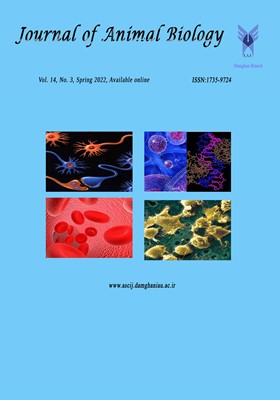Study of Accumulation of Heavy Metals (Pb & Cd) in Muscle, Skin, and Gill Tissues Chalcalburnus Chalcoides (Anzali & Shirud Lagoon)
Subject Areas : Journal of Animal Biology
Mohammad Bostanmanesh
1
,
Mahnaz Sadat Sadeghi
2
*
![]() ,
Mojgan Emtiyazjoo
3
,
Mojgan Emtiyazjoo
3
1 - Department of Marine Biology, Islamic Azad University, North Tehran Branch, Tehran, Iran
2 - Department of Marine Biology, Islamic Azad University, North Tehran Branch, Tehran, Iran
3 - Department of Marine Biology, Islamic Azad University, North Tehran Branch, Tehran, Iran
Keywords: Caspian Sea, Chalcalburnus chalcoides, Heavy metals, Gilan and Mazandaran Provinces,
Abstract :
We studied concentration of heavy metals Pb and Cd in the Gill, Skin, and Muscle tissues of Chalcalburnus Chalcoides caught from the southern Caspian Sea (Anzali & Shirud lagoon) in spring 2012. After biometrical measurements, the Gill, Skin, and Muscle tissues of samples were separated; metals were extracted from the tissues using chemical digestion method with pure nitric acid and their concentrations were determined by AAS. Average concentrations (in ppm dry weight) were compared with international standards such as FAO, WHO, and Stoskopf. Results showed that in Shirud of Mazandaran in gills, skin and muscle tissues, the maximum average accumulation belonging to Pb are 9.5836 ± 2.52069, 5.9343 ± 1.08995, 6.0264 ± 1.45947 µg/g and minimum average belonging to Cd are 0.0936 ± 0.04763, 0.0957 ± 0.04236, 0.0393 ± 0.02227 µg/g, respectively. In Anzali of Gilan, in gills, skin, and muscle tissues maximum average accumulation belonging to Pb are 20.8380 ± 3.68153, 7.6880 ± 2.04173, 3.5653 ± 0.68273 µg/g and minimum average belonging to Cd are 0.6040 ± 0.22663, 0.1167 ± 0.03897, 0.0233 ± 0.00893 µg/g, respectively. Lead concentrations in this study in both areas compared to international standards of WHO, Netherlands, EOS, and EPA limit is reached, but according to the EPA standard, the muscles in Gilan province are lower than the limit. Cadmium concentrations in all tissues except gill-based standards are lower. The average concentration of lead and cadmium metals between muscle, skin, and gills in Gilan province showed significant difference (P<0.05) and average concentrations of lead and cadmium in the tissues in Mazandaran province were not significantly different (P> 0.5).
19. Rashed M.N. 2001. Monitoring of environmental heavy metals in fish from Nasser Lake. Environment International- Elsevier, 27(1): 27-33.
_||_

